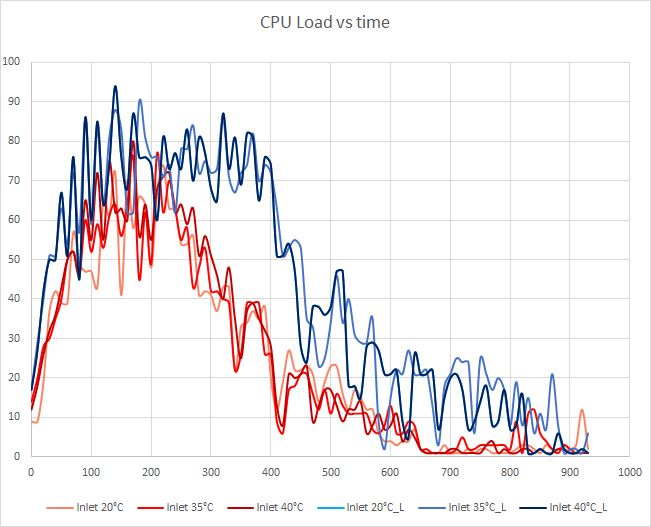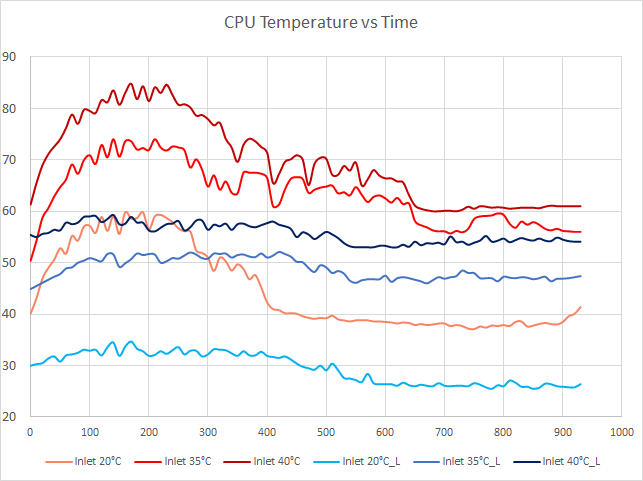Free Cooling: the Server Side of the Story
by Johan De Gelas on February 11, 2014 7:00 AM EST- Posted in
- Cloud Computing
- IT Computing
- Intel
- Xeon
- Ivy Bridge EP
- Supermicro
Loading the Server
The server first gets a few warm-up runs and then we start measuring during a period of about 1000 seconds. The blue lines represent the measurements done with the Xeon E5-2650L, the orange/red lines represent the Xeon E5-2697 v2. We test with three settings:
- No heating. Inlet temperature is about 20-21°C, regulated by the CRAC
- Moderate heating. We regulate until the inlet temperature is about 35°C
- Heavy heating. We regulate until the inlet temperature is about 40°C
First we start with a stress test: what kind of CPU load do we attain? Our objective is to be able to test a realistic load for a virtualized host between 20 and 80% CPU load. Peaks above 80% are acceptable but long periods of 100% CPU load are not.
There are some small variations between the different tests, but the load curve is very similar on the same CPU. The 2.4GHz 12-core Xeon E5-2697 v2 has a CPU load between 1% and 78%. During peak load, the load is between 40% and 80%.
The 8-core 1.8GHz Xeon E5-2650L is not as powerful and has a peak load of 50% to 94%. Let's check out the temperatures. The challenge is to keep the CPU temperature below the specified Tcase.
The low power Xeon stays well below the specified Tcase. Despite the fact that it starts at 55°C when the inlet is set to 40°C, the CPU never reaches 60°C.
The results on our 12-core monster are a different matter. With an inlet temperature up to 35°C, the server is capable of keeping the CPU below 75°C (see red line). When we increase the inlet temperature to 40°C, the CPU starts at 61°C and quickly rises to 80°C. Peaks of 85°C are measured, which is very close to the specified 86°C maximum temperature. Those values are acceptable, but at first sight it seems that there is little headroom left.
The most extreme case would be to fill up all disk bays and DIMM slots and to set inlet temperature to 45°C. Our heating element is not capable of sustaining an inlet of 45°C, but we can get an idea of what would happen by measuring how hard the fans are spinning.












48 Comments
View All Comments
iTzSnypah - Tuesday, February 11, 2014 - link
I wonder why nobody has tried geothermal liquid cooling. You could do it 2 ways. Either with a geothermal heat pump set up or cut out the middle man and just use the earth like you would a radiator in a liquid cooling loop. The only problem would be how many wells you would have to drill to cool up to 100MW (I'm thinking 20+ at a depth of at least 50ft).ShieTar - Tuesday, February 11, 2014 - link
Its kind of easier to just use a nearby river than dig for and pump up ground water. That's what power stations and big chemical factories do. For everybody else, air-cooling is just easier and less expensive.iTzSnypah - Tuesday, February 11, 2014 - link
You wouldn't be drilling for water. You drill a well so you can put pipe in it, fill it back up and then pump water through the pipes using the earth's constant temp (~20c) to cool your liquid which is warmer (>~30c).looncraz - Tuesday, February 11, 2014 - link
I experimented with this (mathematically) and found that heat soak is a serious, variable, concern. If the new moisture is coming from the surface, this is not as much of an issue, but if it isn't, you could have a problem in short order. Then there are the corrosion and maintenance issues...The net result is that it is cheaper and easier to just install a few ten thousand gallon coolant holding tanks and keep them cool (but above ambient) and to cool the air in the server room(s). These tanks can be put inside a hill or in the ground for extra installation and a surface radiator system could allow using cold outside air to save energy.
superflex - Wednesday, February 12, 2014 - link
You obviously dont know have a clue about drilling costs.For a 2,000 s.f. home, a geothermal driller needs between 200-300 lineal feet of well bore to cool the house. In unconsolidated material, drilling costs per foot range from $15-$30/foot, depending on the rig. For drilling in rock, up the cost to $45/foot.
For something that uses 80,000x more power than a typical home, what do you think the drilling costs would be?
Go back to heating up Hot Pockets.
chadwilson - Wednesday, February 19, 2014 - link
That last statement was totally unnecessary. Your perfectly valid point was tarnished by your awful attitude.nathanddrews - Tuesday, February 11, 2014 - link
Small scale, but really cool. Use PV to power your pumps...http://www.overclockers.com/forums/showthread.php?...
Sivar - Tuesday, February 11, 2014 - link
Geothermal heat pumps are only moderately more efficient than standard air conditioning and require an enormous amount of area. 20 holes at a depth of 50ft would handle the cooling requirements for a large residential home, but wouldn't even approach the requirements for a data center.One related possibility is to drill to a nearby aquifer and draw cool water, run it through a heat exchanger, then exhaust warm water into the same aquifer. Unfortunately, water overuse has been drained aquifers such that even the pumping costs would be substantial, and the aquifers will eventually be drained to the point that vacuum-based pumps can no longer draw water.
rkcth - Tuesday, February 11, 2014 - link
They are a lot more efficient at heating, but only mildly more efficient at cooling. They also are really storing heat in the ground in the summer and taking it back in the winter, so if you only store heat you can actually have a problem long-term. Your essentially using the ground as a long-term heat storage device since the ground is between 50-60 degrees depending on your area of the country, but use of the geothermal changes that temperature. An air source makes much more sense since you share the air with everyone else and it essentially just blows away.biohazard918 - Tuesday, February 11, 2014 - link
Wells don't use vacuum based pumps most aquifers are much to deep for that instead you stick the pump in the bottom of the well and push the water to the service.